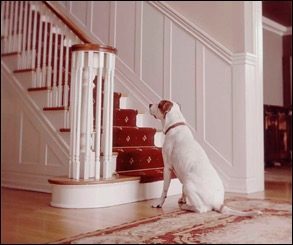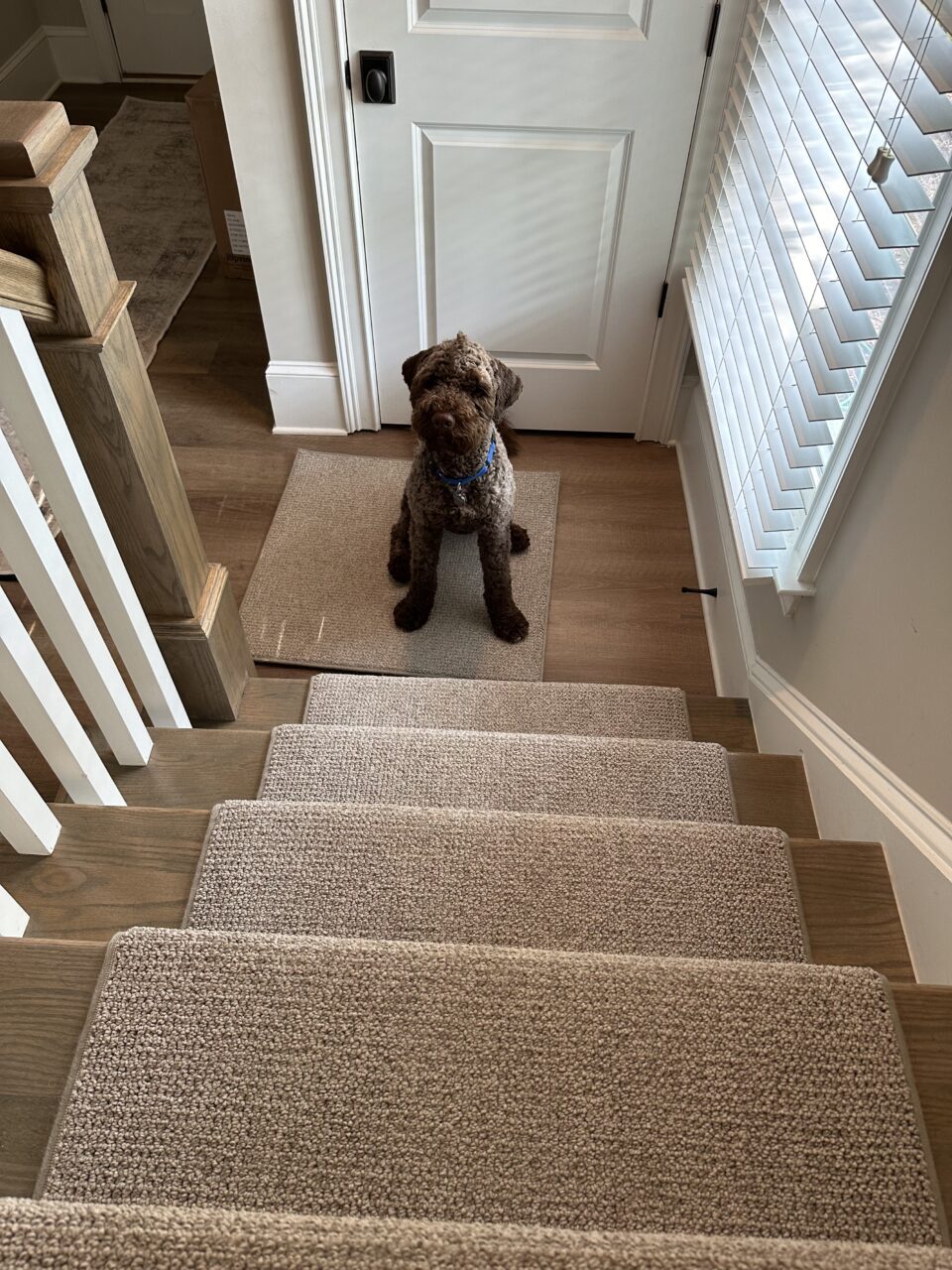Help clients understand how simple modifications can help their dog
I once had a client ask me how they should build their new house to best accommodate their dog with OA. Oh, if everyone had the opportunity, forethought and desire to design their home around their dog’s needs!
If we were designing the ideal OA friendly home, it would have the following:
- Carpet throughout
- A carpeted staircase of about 8 steps
- An elevator to use rather than going down steps
- A room set up for the dog’s gym
- Orthopedic dog beds throughout
- Excellent insulation to maintain a perfectly comfortable room temperature
- A pool and hot tub for the dog
- A fenced yard
- A loading dock for the dog to easily get in and out of the car rather than jumping down
Since most of the time we don’t get to build this dream house from scratch, we need to make recommendations for how clients can modify their current home to help their dog with OA.
Human occupational therapists will often visit their patient’s homes and make suggestions for modifications based on the individual’s injury or disability and particular home environment.
When working with clients of dogs with OA, it is important to ask questions about what the home is like (carpet? stairs?), what the dog needs to do in the home (stairs? Get on the owner’s bed?), and what they struggle with. Viewing pictures or videos of the home may also provide insight. For example, does the dog struggle to get out of their bed because the bed is positioned right next to a step or on a slick surface?
Here are a few basic suggestions for home environment modifications. Each dog and client will be unique, so there may be other scenarios that will require modifications to improve the dog’s ability to function in their home environment.
FLOORING
The first and perhaps most important recommendation is to ensure the flooring provides traction for the dog to stand up. There are products such as booties or toe grips that are designed to help dogs stand on slick floors, but these do not work for many dogs and are certainly less helpful than providing a non-slippery surface under their feet.
This will mean covering up tile, hardwood, vinyl and other slick surfaces with rugs, yoga mats or gym floor tiles. When carpet runners or area rugs are placed, it is important that a non-skid pad is placed beneath the rug. Any area where the dog is desired to be should have plenty of non-slick flooring, including directly under the dog bed.
STAIRS
 The next discussion is regarding stairs. Sometimes stairs are unavoidable, particularly if they are needed to enter/ exit the house. The primary concern with stairs comes if they are slick (hardwood), narrow, steep, or circular (and worst- all of the above!).
The next discussion is regarding stairs. Sometimes stairs are unavoidable, particularly if they are needed to enter/ exit the house. The primary concern with stairs comes if they are slick (hardwood), narrow, steep, or circular (and worst- all of the above!).
I am actually a proponent of medium and large breed dogs with OA walking upstairs—this is a great form of active range of motion, strengthening and proprioception. I actually believe that my own dogs with OA maintained their mobility because they had to do stairs every day. However, walking down-stairs does not provide the same advantages—forces on the front limbs are increased and it takes a lot of control to walk down slowly. Dogs with elbow and carpal OA have a particularly difficult time going downstairs. If stairs are part of a dog’s activity of daily living (ie, they must do as part of their home life), the stairs should be non-slick- either with carpet or treads such as this. Remember to put a non-slip mat at the base of the stairs! It is also a good idea to assist dogs going down stairs using a harness with a handle on top (Help em Up or other) or sling to help support and slow the descent.
For small breed dogs with OA, we recommend carrying them up and down stairs- the effort it takes them to go up stairs is like a human having to do a box jump for each step. This can place excessive force on their spines.
BEDDING
 All dogs deserve a warm, comfortable, safe place to rest. Many dogs will sleep on the human bed, others will sleep in their crate, and some will rest on the floor despite multiple bedding options. The recommendations for dogs with OA are the following:
All dogs deserve a warm, comfortable, safe place to rest. Many dogs will sleep on the human bed, others will sleep in their crate, and some will rest on the floor despite multiple bedding options. The recommendations for dogs with OA are the following:
- Supportive bedding, such as memory foam mattresses, should be provided.
- Bedding should be placed in a warm/ non-drafty area of the house, and non-slick flooring should be under/ around the bed.
- If the dog is crate trained, the crate should be large enough for them to stand up, move around and stretch out; and the crate should have supportive bedding.
- If dogs are sleeping on the human bed, ideally they should not be jumping off the bed but should use stairs or a ramp, particularly if the bed is high.
- Consider recommending pulsed electromagnetic field beds, such as the Respond PEMF bed. These PEMF beds can be placed on top or under the dogs’ bed and can provide non-pharmaceutical pain relief.
NAILS and FOOT CARE
 It is very important to keep toenails trimmed short. Over-grown nails will change the biomechanics of the digits and could lead to arthritis in the toes. Long nails will also prevent dogs from getting traction on slick floors.
It is very important to keep toenails trimmed short. Over-grown nails will change the biomechanics of the digits and could lead to arthritis in the toes. Long nails will also prevent dogs from getting traction on slick floors.
Ideally, clients are able to trim their dog’s nails at home regularly (at least once a month). A Dremel tool may be more tolerated by the dog and is less likely to “quick” the nail.
Dogs should be trained to the Dremel tool (or any nail cutting tool) from a young age ideally, though older dogs can be conditioned to the task using a lot of high-value rewards and patience. It may take months to train the dog to allow nail trimming, but in the end, it will be worth it. For clients that are unable to trim the nails, regular TNT appointments should be made.
Dogs with long hair, or feathers, between their pads should have this hair trimmed regularly to improve foot traction.
FEEDING STATION
Raising the food and water bowl can help dogs with OA. When eating from a bowl on the floor, dogs shift more weight to the front limbs. Dogs with carpal, elbow, shoulder and neck OA may have a difficult time reaching down to eat or drink.
Dogs with pelvic limb OA already shift more weight to their front limbs, and then when eating they would further overload the front legs, potentially leading to compensatory muscle issues in the shoulder and neck.
Raising the bowl to the level that allows a neutral spine and minimal neck flexion will shift weight back on the pelvic limbs, which is actually a good form of exercise for dogs with pelvic limb OA (isometric strengthening). The ideal level of the food bowl is typically at about the dog’s shoulders. There are many commercially available elevated feeders such as this.

